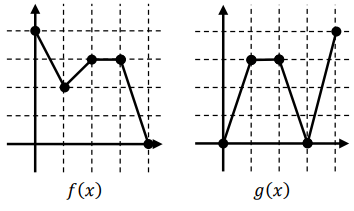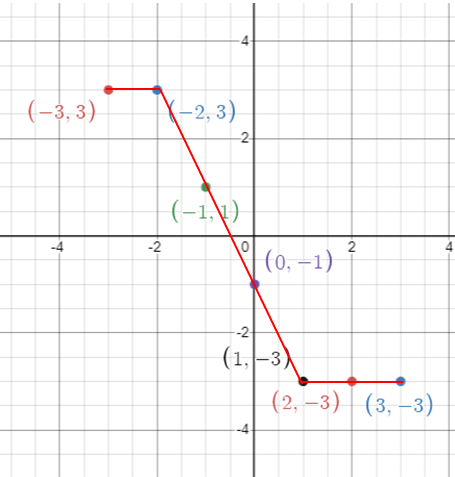SKETCH THE GRAPH OF F PLUS G FROM THE GRAPH
Problem 1 :

a) Sketch the graph of f + g. (Hint: For any x value, add the y values of f and g.)
b) What is the domain of f + g? Explain how you obtained your answer.
Solution:
a)

b)
Solution:
The domain of (f + g) is (-3, 6).
Problem 2 :

a) Sketch the graph of f - g. (Hint: For any x value, subtract the y values of f and g.)
b) What is the domain of f - g? Explain how you obtained your answer.
Solution:
a)

b)
Solution:
The domain of (f - g) is (-3, 6).
Problem 3 :
Use the graphs below to compute the following values.
a) (f + g) (1)
b) (f - g) (2)
c) (g - f) (3)
d) (f g) (4)
e) (f / g) (1)
f) (g / f) (4)

Solution :
a) (f + g) (1)
(f + g) (1) = f(1) + g(1)
= 4 + 3
(f + g) (1) = 7
b) (f - g) (2)
(f - g) (2) = f(2) - g(2)
= 3 - 3
(f - g) (2) = 0
c) (g - f) (3)
(g - f) (3) = g(3) - f(3)
= 0 - 3
(g - f) (3) = -3
d) (f g) (4)
(f g) (4) = f(4) g (4)
= 0 (4)
(f g) (4) = 0
e) (f / g) (1)
(f / g) (1) = f(1) / g(1)
= 4/3
(f / g) (1) = 4/3
f) (g / f) (4)
(g / f) (4) = g(4) / f(4)
= 4/0
(g / f) (4) = undefined
Problem 4 :
Use the graphs of the function f and g

a) Sketch the graph of (f + g)(x)
b) Sketch the graph of (f - g)(x)
Solution :
|
x -3 -2 -1 0 1 2 3 |
f(x) 1 0 -1 -2 -3 -2 -1 |
g(x) 2 3 2 1 0 -1 -2 |
(f + g)(x) 3 3 1 -1 -3 -3 -3 |
Ordered pairs for (f + g)(x) :
(-3, 3) (-2, 3) (-1, 1) (0, -1) (1, -3) (2, -3) (3, -3)

|
x -3 -2 -1 0 1 2 3 |
f(x) 1 0 -1 -2 -3 -2 -1 |
g(x) 2 3 2 1 0 -1 -2 |
(f - g)(x) -1 -3 -3 -3 -3 -1 1 |
Ordered pairs for (f - g)(x) :
(-3, -1) (-2, -3) (-1, -3) (0, -3) (1, -3) (2, -1) (3, 1)

Problem 5 :
Betty is in the market for a new flat screen TV. She has two coupons that she can use to purchase the television. One coupon for 20% off the original price and the other coupon is for $100 off the original price.
a) Write the function p(x) to represent the discounted price of the television after the 20% off coupon is applied.
b) Write the function d(x) to represent the discounted price of television after the $100 off coupon is applied.
c) Which coupon should Betty use ?
Solution :
Let x be the original price.
P(x) = (100 - 20)% of x
= 80% of x
= 0.80x
b) d(x) = x - 100
c) 0.80x = x - 100
0.80x - x = - 100
-0.20 x = -100
x = 100/0.20
x = 500
If the price of TV is greater than 500, then 20% offer is the better deal.
Recent Articles
-
Finding Range of Values Inequality Problems
May 21, 24 08:51 PM
Finding Range of Values Inequality Problems -
Solving Two Step Inequality Word Problems
May 21, 24 08:51 AM
Solving Two Step Inequality Word Problems -
Exponential Function Context and Data Modeling
May 20, 24 10:45 PM
Exponential Function Context and Data Modeling